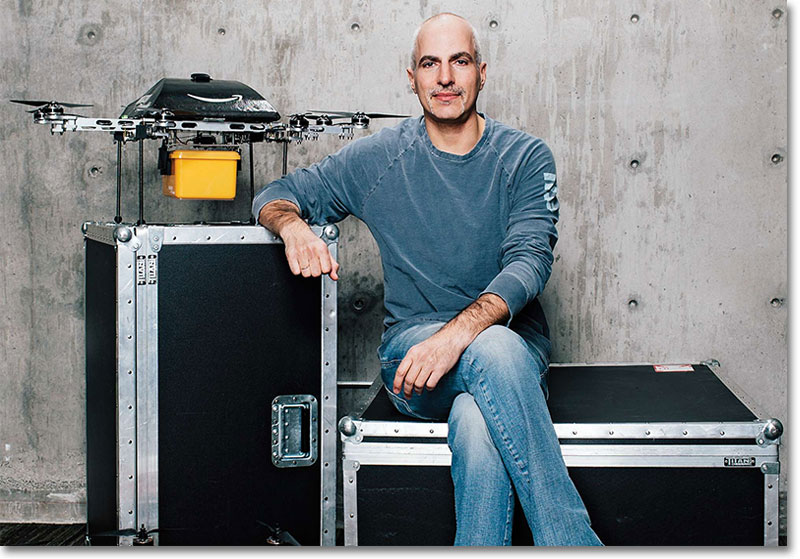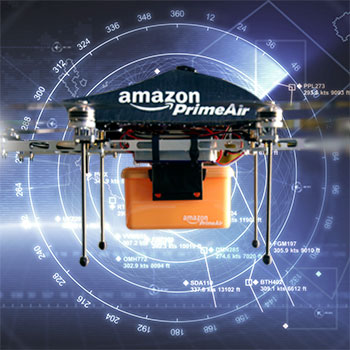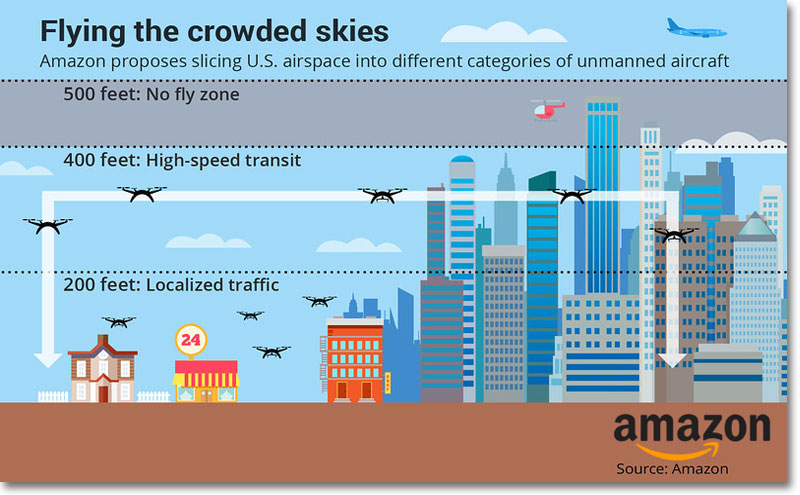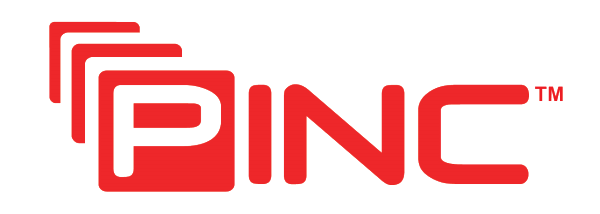Amazon’s Top Prime Air Executive Outlines Plans for Delivery Drones to Navigate Skies

Amazon has laid out a proposal centered on slicing U.S. airspace into segments for different categories of unmanned delivery aircraft, while keeping them all away from airplanes.
At NASA’s UTM Convention, Amazon laid out its vision for a multi-tiered superhighway in the sky, one in which all drones flying above 200 feet would have the ability to communicate with - and ideally sense and avoid - other aircraft.
It’s an attempt to put an end to the Wild West atmosphere that has been the norm for Unmanned Aircraft Systems (UAS) over the last five years, replacing it with a next-generation air traffic control system.
It hopes to establish a basic regulatory framework and set of technical standards that manufacturers can work toward.
All this would prepare the airspace for a time when thousands, even tens of thousands of drones fly over the average city delivering parcels, monitoring air quality, and handing out parking tickets.
Amazon’s proposal, which is in line with similar ideas floated by NASA and Google, would create a slow lane for local traffic below 200 feet and a fast lane for long-distance transport between 200 and 400 feet.
Altitudes between 400 and 500 feet would become a no-fly zone, and anything above that is already against FAA regulations for hobbyists.
While some commercial drone operators are pushing to fly large UAS above 500 feet, Amazon is avoiding that discussion for now.

Gur Kimchi, VP, Prime Air at Amazon | Image: Jose Mandojana (Popular Science)
As reported by the Washington Post, Gur Kimchi, vice president of Amazon Prime Air, shared the company’s proposal at the NASA Ames Research Center for how drones could operate safely in cities, suburbs and beyond around the world.
Amazon suggests divvying up airspace access based on a drone’s mission and capabilities. Drones would connect to an online network that manages their flights in real time to prevent any trouble. Amazon believes this approach will ensure safe and efficient drone flights.
Kimchi is calling for airspace under 200 feet to be designated for low-speed localized traffic. Drones in this space might be surveying, shooting videos or conducting inspections. Drones without the best collision-avoid technology would also be restricted to this level.
While that airspace would be like a local service road, between 200 and 400 feet would serve as a highway for drones. Most of these drones would be flying autonomously.
A drone making a long commute to conduct a mapping operation or package delivery could speed along in airspace populated by drones only with the most sophisticated sense-and-avoid technologies.
These drones would communicate with each other and be able to detect hazards not on the drone network, such as birds. The airspace between 400 and 500 feet would be left empty as a buffer between drones and planes.
Only drones with the best capabilities - such as technology capable of detecting and avoiding birds - would be allowed to fly in urban areas. Sense-and-avoid technology is critical as companies such as Amazon want their drones to fly autonomously, so a human won’t be present to avert a collision with a pigeon, skyscraper or helicopters.
Amazon thinks drones can fly safely in urban areas, provided they have an array of cutting-edge technologies, which are still being developed and tested by Amazon and others.
It believes drones flying over cities should have geospatial data to avoid known hazards such as buildings; online flight planning and management; an Internet connection; sense-and-avoid that communicates with other drones, plus sense-and-avoid that uses sensors to detect unexpected obstacles such as birds.
Delivering packages via drones could be a boon for Amazon if it cuts its shipping costs (they spent $4 billion last year on shipping costs) and speeds up deliveries for customers.
Its vision is more ambitious than the FAA’s proposed rules for commercial drone flight, which do not allow operation outside of a pilot’s line of sight. Those rules are expected to be finalized within a year.
Now we’ll see if drone operators such as Amazon can demonstrate to the FAA and others that autonomous drones can safely fly in a range of environments.
If that happens, the full potential of drones could be realized.
Related Read: Sony Creates Drone Company to Find More Enterprise Customers for Its Image Sensors

Article Topics
PINC News & Resources
Transport Analytics for Enterprise Rail Visibility Mobile Device Procurement, Service, and Support for Industrial & Finished Goods Shippers Merger of Best-in-Class Supply Chain Companies PINC, ShipXpress, and RailCarRX Providing Enhanced Yard Management Services and Solutions to Enterprise Customers 2020 State of Yard Management Report: Identifying a Truckload of Savings Across Your Network The Impact of Digital Yard Management on Enterprise Transportation Costs and Capacity The Increasing Demand for Digital Yard Management Systems More PINCLatest in Transportation
UPS Cuts Email Response Time in Half with AI Automation Five Innovations Shaping the Future of Last-Mile Delivery Barge Hits Texas Bridge in Incident Reminiscent of Baltimore Collapse Freight Shipments Continue Downward Trend in April Record High in Container Production Expected for 2024 VIDEO: Baltimore’s Francis Scott Key Bridge Demolished in Controlled Explosion USPS Sees Increase in Revenue but Overall Net Loss in Q2 More Transportation














